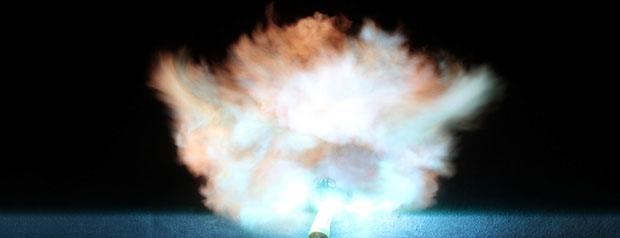
[Patrick] didn’t just want his name in lights. He wanted his name in glowing plasma explosions, made by sending thousands of volts through a very thin wire.
This project is an experiment in capturing high speed images of exploding wires. [Patrick] wanted to know if he could shape wires in such a way that they would explode into letters of plasma. Of course, photographic proof of this would be needed, and would make for an awesome logo in any event.
To get pictures of wire turning into plasma, [Patrick] first needed to construct the necessary electronics. A simple spark gap was constructed on a large plastic cutting board – an excellent high voltage insulator. The huge capacitors are charged with a pair of high voltage transformers, and the entire assembly is triggered with an optocoupler and a very beefy SCR.
Even though [Patrick] designed the system for a low propagation delay, there was still the matter of capturing an exploding wire on film. The camera delay varied by about 120μs, but with a really great camera trigger, [Patrick] eventually got some impressive pictures.
After getting the electronics and photography portion of the build down, [Patrick] turned to making letters out of expanding plasma. Simply shaping the wire into a letter shape before vaporizing it had no effect, so he turned to 3D printed channels to contain the plasma. After a few attempts, this actually worked, allowing him to form the letters L, U, and X in an expanding ball of vaporized wire.
















For ‘some’ reason, photography of exploding wires is among the most highly documented photographic subjects in history…
If you are thinking what I am thinking that was one of my first thoughts as well.
One of those late sleepless nights when one drifted further and further away from what I started looking at, I found all kinds of things on Wikipedia et al. Searching for “exploding wire” could undoubtedly take someone else on a similar reading spree.
“…made by sending thousands of volts through a very thin wire.”
Ugh. As a site that caters to electrical related projects this is pretty poor.
Voltage, current, energy, and power are all the same thing, right? :P
…the more so when the second par of the link actually says “a high current pulse”.
It’s not unreasonable to expect HaD to have a better grasp of basic physics than the average cruddy newspaper.
Using a mechanical shutter at 1/8000 seems . . . silly. The scan rate of the shutter is not going to be fast enough to capture the actual explosion, and you’ll get something like a scan line video in single frame. The author even notes the issue in the article. The fact that the shutter is probably taking 1/250 to 1/500 to travel from top-bottom or left-right will have a distorting effect on the image.
A non-mechanical shutter on a mirror-less camera would be much better suited to a job like this.
With the proper ND filter to get the right exposure, the plasma should be short-lived (and bright) enough to create the image with a long exposure. Turn off the lights, open the shutter, explode your wire, and you’re done. ;)
But then you get the plasma cloud travel and flying molten metal bits trailing… Possibly wire movement as well, causing massive blurring.
Yup. As Patrick says: “Things happen so quickly that in the time taken for the shutter to scan the sensor, quite a lot happens.”
There’s copious rolling shutter distortion in the images, due to the 125 microseconds that it takes the shutter slit to travel across the image. However, for any particular pixel, the image shows information from the 10 microseconds where the slit and the pixel line up. And yes, we’d love to use a faster camera with a global shutter, but that starts to get very expensive.
You don’t send volts trhough a wire, you send amps.
Pedantic as it may be this is also incorrect. Current is the travel of charge through a conductor.
Amperes are the units of current.
But, at any rate, we love blowing things up.
So I wonder if this could be used as a blasting cap for explosives? I know they used exploding bridge wire detonators on nukes.
I saw this and thought of exploding bridge-wire detonators, which did stem from me surfing wikipedia on a late night.
i have done exploding wire stuff. works very well with a proper camera. only 100 grand or so. 50 grand for the basic camera then there are the lenses and the lighting to consider. we used 8kw of dc discharge lamps. if you use ac lighting you get the 50 cycle mains pulses. of course i wasnt paying for any of this.